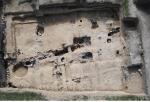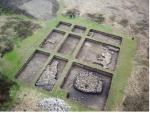Summary (English)
PLISKA (Pavel Georgiev – pavel_g@gbg.bg, Radoslav Vasilev, Tihomir Tihov) The Small Timber Fortification was explored in the northwestern part of the Inner Town. It was the predecessor of the Large Timber Fortification, which was explored from 1977 to 2006 and was the most inner fortification in Pliska before the city was destructed by the Byzantine army in AD 811. Trench XIV. A platform paved with bricks and wooden boards was explored. The southeastern corner of the Small Timber Fortification was documented below it. The platform was constructed immediately after AD 811. A stove with an adjacent chamber of bricks No. 3, chamber of bricks No. 4 and three pits were discovered. Chamber No. 3 contained a copper earring, a glass bead, shells from eggs, a terracotta spindle whorl, a bone awl, bones from animals and fish, and sherds of the 9th century AD. Chamber No. 4 contained a copper earring, animal bones and sherds. The chambers were used for ritual activities and were situated close to stoves Nos. 1 – 3 where the food was cooked. The remains from the rituals were placed inside the pits. Pit No. 2 contained terracotta spindle whorls, 14 knucklebones and a piece of quartz. The platform was used for public meetings and rituals. Trench XVIII. The southern entrance of the Small Timber Fortification had a layout similar to the layout of the southern entrance of the later Citadel of Pliska. There were ovens close to House No. 2. A stove with two chambers and a storage pit containing shovels and an axe were discovered in House No. 1. In addition, spindle whorls, awls, jewelry and a coin of Nikephoros II Phokas restamped over an earlier emission were found in House No. 1. Trench XX. Over 15 semi-dug sunken-floored houses and two Christian burials of adults dated to the 10th – 11th centuries were explored. Trenches of timber buildings of the 8th – 9th centuries AD were documented. The finds included pottery, three coins of the 4th – 5th centuries AD, a fourrée of Basil I the Macedonian and Constantine, a follis of Leo VI the Wise, anonymous Byzantine folles of Classes A1, A2, B and C, an Ottoman silver akçe of Sultan Mehmed II, finger-rings (one of them with a plate showing a bust of Christ), belt appliqués, crosses-encolpia, arrowheads, a bronze mace, terracotta and lead spindle whorls, and bone awls.
- Pavel Georgiev - Shumen Branch of the Archaeological Institute and Museum
- Radoslav Vasilev - Archaeological Institute with Museum
- Tihomir Tihov - Regional Museum of History – Shumen
Director
Team
Research Body
- Archaeological Institute with Museum
- Regional Museum of History – Shumen
- Shumen Branch of the Archaeological Institute and Museum






![Download [PDF]](/excavation/skins/fasti/images/results/download_sml.png)

